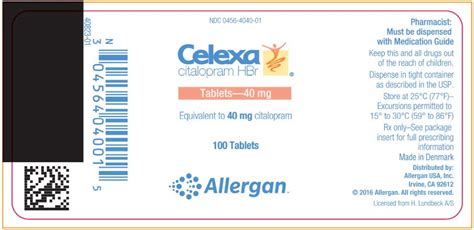Intro
Discover Celexa side effects, including common and rare symptoms, interactions, and withdrawal effects, to understand the potential risks of this antidepressant medication and manage its impact on mental health.
The importance of understanding the side effects of prescription medications cannot be overstated, particularly when it comes to antidepressants like Celexa. Celexa, also known by its generic name citalopram, is a selective serotonin reuptake inhibitor (SSRI) used to treat depression and various other mental health conditions. While it can be an effective treatment for many, it's crucial for patients to be aware of the potential side effects they may experience. This knowledge not only helps in managing expectations but also in making informed decisions about their healthcare.
Celexa, like other SSRIs, works by increasing the levels of serotonin in the brain, which helps improve mood, sleep, and appetite. However, this alteration in brain chemistry can lead to a range of side effects, some of which may be mild and temporary, while others can be more severe and persistent. It's also worth noting that everyone's body reacts differently to medications, and what may cause significant side effects in one person might have little to no effect on another. This variability highlights the importance of personalized medical care and ongoing communication between patients and their healthcare providers.
The impact of Celexa side effects on daily life can be significant, affecting not just the individual taking the medication but also their loved ones. Side effects can range from physical symptoms like nausea and changes in appetite to emotional and psychological effects such as anxiety and mood swings. Understanding these potential side effects is crucial for managing them effectively and ensuring that the benefits of the medication outweigh the drawbacks. By being informed, individuals can work closely with their healthcare providers to adjust their treatment plans as needed, whether that involves changing the dosage, switching to a different medication, or incorporating additional therapies to mitigate side effects.
Celexa Side Effects Overview

When considering Celexa as a treatment option, it's essential to have a comprehensive understanding of its side effects. Common side effects include dizziness, drowsiness, sweating, and changes in sexual desire or ability. More severe side effects, although less common, can include increased risk of suicidal thoughts, especially in young adults, and serotonin syndrome, a potentially life-threatening condition caused by excessive levels of serotonin in the body. It's also important to note that stopping Celexa abruptly can lead to withdrawal symptoms, emphasizing the need for gradual tapering under medical supervision.
Common Side Effects of Celexa
Some of the most frequently reported side effects of Celexa include: - Nausea or vomiting - Diarrhea - Dry mouth - Increased sweating - Fatigue - Sleep disturbances - Changes in appetite or weight - Sexual dysfunctionThese side effects often diminish over time as the body adjusts to the medication, but in some cases, they may persist or significantly impact the individual's quality of life. It's crucial for patients to discuss any side effects they are experiencing with their healthcare provider, as adjustments can often be made to alleviate these issues.
Severe Side Effects of Celexa

While less common, severe side effects of Celexa can have significant health implications. These include:
- Allergic reactions, which can be life-threatening
- Increased risk of bleeding, particularly when combined with other medications like NSAIDs or aspirin
- Hyponatremia, a condition characterized by low sodium levels in the blood
- Seizures, although rare
- Serotonin syndrome, as mentioned earlier, which requires immediate medical attention
It's vital for patients and their families to be aware of these severe side effects and to seek medical help immediately if they suspect any of these conditions.
Managing Celexa Side Effects
Managing side effects effectively is key to ensuring that treatment with Celexa is successful and that the individual can lead a fulfilling life. This can involve: - Regular monitoring by a healthcare provider - Adjusting the dosage of Celexa - Adding other medications to counteract specific side effects - Lifestyle changes, such as regular exercise, a balanced diet, and stress management techniquesCommunication is paramount; patients should never hesitate to discuss their side effects or concerns with their healthcare provider. Together, they can work towards finding the best approach to manage side effects and improve overall well-being.
Celexa and Pregnancy

For women who are pregnant or planning to become pregnant, the decision to take Celexa or any antidepressant must be made with careful consideration. While Celexa can be beneficial for managing depression during pregnancy, there are potential risks to the fetus, including an increased risk of congenital heart defects and potential complications during delivery. The decision should be made in consultation with a healthcare provider, weighing the benefits of treatment against the potential risks to the fetus.
Celexa Withdrawal
Stopping Celexa abruptly can lead to withdrawal symptoms, which can range from mild to severe. These symptoms may include: - Dizziness - Headache - Nausea - Irritability - Flu-like symptomsTo avoid these symptoms, healthcare providers recommend tapering off Celexa gradually. The rate at which the dosage is reduced will depend on the individual and the length of time they have been taking the medication. It's essential to follow the tapering schedule provided by the healthcare provider to minimize discomfort and risk.
Celexa Interactions

Celexa can interact with a variety of other medications, either reducing their effectiveness or increasing the risk of side effects. It's crucial for patients to inform their healthcare provider about all medications they are taking, including over-the-counter drugs, herbal supplements, and vitamins. Some medications that can interact with Celexa include:
- Other antidepressants
- Blood thinners
- Certain antibiotics
- Medications for migraine headaches
- St. John's Wort
These interactions can lead to serious health issues, so it's vital to manage medications carefully under the guidance of a healthcare provider.
Celexa Dosage
The dosage of Celexa can vary depending on the individual's condition, age, and how they respond to the medication. Typically, treatment starts with a lower dose that may be increased as needed and under medical supervision. It's essential to follow the prescribed dosage and not to adjust it without consulting a healthcare provider, as this can impact the medication's effectiveness and increase the risk of side effects.Celexa Alternatives

For some individuals, Celexa may not be the best treatment option due to side effects, interactions with other medications, or lack of effectiveness. In such cases, alternative treatments may be considered. These can include:
- Other SSRIs or antidepressants
- Psychotherapy, such as cognitive-behavioral therapy (CBT)
- Lifestyle modifications, including diet, exercise, and stress management
- Alternative therapies, such as mindfulness or acupuncture, although their effectiveness may vary and should be discussed with a healthcare provider
The choice of alternative treatment depends on the individual's specific situation and should be made in consultation with a healthcare provider.
Conclusion and Next Steps
In conclusion, while Celexa can be an effective treatment for depression and other mental health conditions, it's essential to be aware of its potential side effects and to work closely with a healthcare provider to manage them. By understanding the benefits and risks of Celexa and maintaining open communication with healthcare providers, individuals can make informed decisions about their treatment and take steps towards improving their mental health and overall well-being.We invite you to share your thoughts and experiences with Celexa in the comments below. If you found this article informative, please consider sharing it with others who might benefit from this information. Your engagement and feedback are invaluable in helping us provide the most relevant and helpful content.
What are the most common side effects of Celexa?
+The most common side effects of Celexa include nausea, diarrhea, dry mouth, increased sweating, fatigue, sleep disturbances, changes in appetite or weight, and sexual dysfunction.
Can Celexa be taken during pregnancy?
+Celexa can be taken during pregnancy, but the decision should be made with careful consideration and under the guidance of a healthcare provider, as there are potential risks to the fetus.
How should Celexa be stopped to avoid withdrawal symptoms?
+To avoid withdrawal symptoms, Celexa should be tapered off gradually under the supervision of a healthcare provider. The rate of tapering will depend on the individual and the length of time they have been taking the medication.
